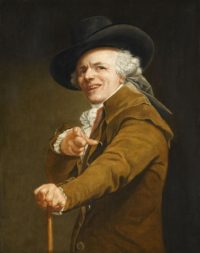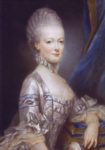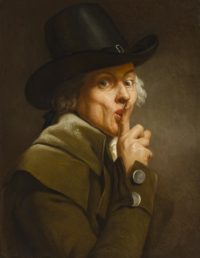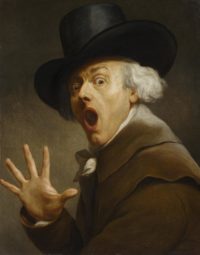 The Nationalmuseum in Stockholm has acquired two self-portraits by French painter and Very Big Deal on the Internet, Joseph Ducreux. If you don’t know his name, you know his face and forefinger, internationally famous stars of the archaic rap meme.
The Nationalmuseum in Stockholm has acquired two self-portraits by French painter and Very Big Deal on the Internet, Joseph Ducreux. If you don’t know his name, you know his face and forefinger, internationally famous stars of the archaic rap meme.
Already established as a portraitist to the Parisian bourgeoisie, Ducreux got his big break in 1769 when he was commissioned to make a miniature of 13-year-old Maria Antonia, Archduchess of Austria so her prospective husband, the Dauphin of France, could see what she looked like before they met in person. The future Queen Marie Antoinette and King Louis XVI were pleased with the result and Ducreux was made a baron and appointed First Painter to the Queen.
 It was in the 1780s that Ducreux began to experiment with a new, highly expressive style of self-portraiture. He used his face and body to explore how character and personality can be depicted through exaggerated postures and facial expressions, even costumes on occasion. By the end of the decade, his mischievous self-portraits were well-known as among the best exponents of physiognomy.
It was in the 1780s that Ducreux began to experiment with a new, highly expressive style of self-portraiture. He used his face and body to explore how character and personality can be depicted through exaggerated postures and facial expressions, even costumes on occasion. By the end of the decade, his mischievous self-portraits were well-known as among the best exponents of physiognomy.
Despite his popularity among the aristocracy of France and deep connections to the royal family in the waning days of the Ancien Regime, he managed to turn Revolutionary enough to survive unscathed. After spending some time in London in 1791, he returned to Paris and, helped by his good friend and foremost painter of the Revolution Jacques-Louis David, he painted and drew portraits of moderate leaders like Mirabeau, Antoine Barnave and Pierre Manuel. In 1793 he sketched the last portrait of the deposed King Louis days before his execution and upon his return to Paris, from not-so-moderate leaders including the Jacobin triumvirate of Maximilien Robespierre, Louis Antoine de Saint-Just and Georges Couthon.
There are few facts about Ducreux’s activities during this brief period [in London in 1791], but we know that he exhibited portraits and self-portraits at the Royal Academy of Arts, including two that were called Surprise mixte [sic] with Terror and Surprise, respectively. Most likely, one of the portraits that Nationalmuseum has now acquired was a later version of the first of the two aforementioned works that had been exhibited in London. The facial expression of the artist is permeated with exaggerated surprise mixed with terror, as shown in his large eyes, gaping mouth and dramatically extended right hand. There is no doubt that these works are self-portraits, but their titles, which describe emotions, such as surprise, show that they were also intended to focus on physiognomy as a phenomenon, in itself. […]
By August 1791, he once again exhibited his work in the Salon in Paris. One example is a work that the catalogue calls Silence, which is currently in the collection of the Spencer Museum of Art in Kansas. Ducreux’s expressive oil portraits, however, were met with both praise and scorn, but regardless garnered a great deal of notoriety, which, in turn, increased the demand for additional works of this sort. Nationalmuseum’s Silence is probably a later version by Ducreux of the work exhibited at the Salon. The artist is portrayed with a powdered wig, a top hat and a brown coat. As often was the case, some of the powder is seen on the artist’s shoulders and coat collar. The portrait depicts his upper body in profile, but the head is turned to the viewer. His right index finger is lifted to his mouth to clearly communicate the need to keep silent.
Ducreux’s interest in physiognomy reflects his time and can more generally be indicative of the favourite scientific theme of the Enlightenment. By combining an expressly physiognomic perspective with a self-portrait, this work may well be viewed as having laid the foundation for new directions in portraiture. This is in no way any kind of caricature, but neither does it any longer have anything of the formal and serious nature of traditional portraiture. Ducreux has attempted to capture in himself, facial expressions that we can see every day, on people, in general. It is perhaps not at all surprising that one of Ducreux’s self-portraits of this type has now become a popular on-line meme, which, in itself, shows this artist’s timeless playfulness and desire to experiment.
Joseph Ducreux died in 1802 of a suspected stroke. He was 67 years old. His fame faded after his death, until the mystical forces of Internet macros brought him to a prominence he could never have imagined achieving in life.

